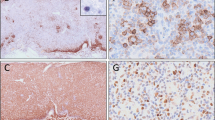Abstract
Due to their minority among the non-Hodgkin lymphomas, classification of extranodal T-cell lymphomas, including those of the natural killer (NK) cell type, has long been controversial and unclear, and the clinical outcome is not well clarified. Recently, new well-defined disease entities have been described based on tumor cell biology combined with anatomical site, clinical features, Epstein-Barr virus (EBV) status, and cell lineage as determined by immunophenotype and genotype. Cytological features are usually not specific, and there are no morphologic correlates with the classification of extranodal T/NK-cell lymphomas. From a human T-cell lymphotropic virus type 1 (HTLV-1) endemic area in Japan, we report here the analysis of 144 cases of extranodal T-cell lymphoma, from which fresh tissues were available. As the clinicopathological features were known, we simply reclassified the cases according to cell lineage and anatomical site. The extranodal T-cell lymphomas were classified into three types on the basis of cell lineage: (1) natural killer cell (NK) type [sCD3-, CD56+, T-cell receptor gene (TCR) germline], (2) cytotoxic T lymphocyte (CTL) type [sCD3+, TIA-1+, TCR rearranged, CD8+/-, CD4-/+], and (3) non-NK/CTL type [sCD3+, TIA-1-, TCR rearranged, CD4+/-, CD8-/+]. In addition to cell lineage, the anatomical site and clinical features were added for subclassification. NK type tumors (35 cases) included the lymphoblastic type, nasal/nasal-type NK lymphoma, and NK leukemia. The CTL type (46 cases) included anaplastic large cell lymphoma (ALCL), cutaneous type, intestinal, γδ T-cell type, and an unspecified type. The non-NK/CTL type (63 cases) included adult T-cell leukemia/lymphoma (ATLL), mycosis fungoides (MF), and an unspecified type. With the exception of ATLL and MF, most extranodal T-cell lymphomas had a cytotoxic phenotype of NK type or CTL type and were often associated with EBV infection. MF and the unspecified type within the non-NK/CTL tumors, with the exception of ATLL, had a favorable prognosis. However, NK and CTL types, with the exception of ALCL, were associated with a poor prognosis. Our results indicate that anatomical site and cell lineage are useful predictors of clinical outcomes of extranodal T-cell lymphomas.
Similar content being viewed by others
Author information
Authors and Affiliations
Additional information
Electronic Publication
Rights and permissions
About this article
Cite this article
Ohshima, K., Liu, Q., Koga, T. et al. Classification of cell lineage and anatomical site, and prognosis of extranodal T-cell lymphoma — natural killer cell, cytotoxic T lymphocyte, and non-NK/CTL types. Virchows Arch 440, 425–435 (2002). https://doi.org/10.1007/s00428-001-0545-1
Received:
Accepted:
Published:
Issue Date:
DOI: https://doi.org/10.1007/s00428-001-0545-1




